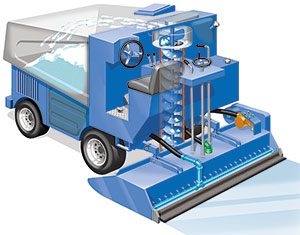
No less a philosopher than Charlie Brown once observed that "there are three things in life that people like to stare at: a flowing stream, a crackling fire, and a Zamboni clearing ice."
In 1949, when Frank Zamboni invented the first ice resurfacing machine, he considered calling it the Paramount in honor of the Los Angeles suburb where he and his brother owned a huge rink. He wisely tossed modesty aside: There are other brands, but the name Zamboni is iconic.
Operators claim it takes a year or two to get the hang of driving one. A Zamboni is capable of speeds up to 9 miles per hour, but most operators prefer to go less than half that fast. Turning at higher speeds can nick the ice.
"The important thing isn’t speed," says Paula Coony, who handles a surprising number of such questions for hte Zamboni company. "It’s the quality of the ice." At many arenas, she adds, "the Zamboni is treated as a mascot."
 The New Jersey Devils’ Zamboni makes a clean sweep at the Rock in Newark.
The New Jersey Devils’ Zamboni makes a clean sweep at the Rock in Newark.
***************************
 1) SHAVING
1) SHAVING
A 57-pound, 70-inch steel blade sharp enough to slice through a stack of newspapers peels the top one-sixteenth of an inch, often less, from the scarred surface of the ice.
2) COLLECTING
A horizontal screw inside the conditioner (the hooded assembly below the driver’s seat) collects the shavings, feeding them to a vertical screw which lifts them to the slinger—a rotating paddle that tosses the shavings into the snow tank at the front of the machine.
3) WASHING
Clean water is fed from the wash tank in front of the driver down to the conditioner. The water is sprayed on the ice in front of a squeegee that collects the water and picks up dirt and other debris, such as tossed coins or broken teeth. These are filtered out before the water is returned to the wash tank for re-use.
 4) RESURFACING
4) RESURFACING
Clean water from a heated tank is spread on the ice by a heavy cloth applicator. Water temperature is critical to ice quality, with 140 degrees a common benchmark. Coils beneath the ice refreeze the surface. Hockey players and speed skaters want harder ice while figure skaters prefer softer ice to help them dig in their edges on landing.
